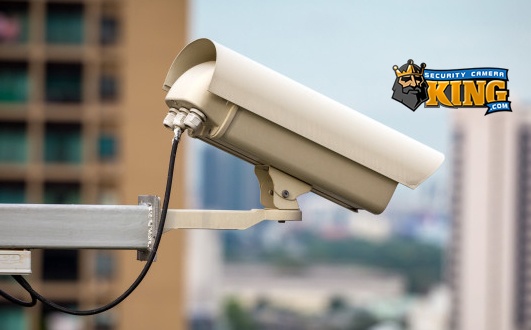For decades analog cameras have been the standard type surveillance camera and these cameras function well but the demand of increased video quality grew over time. Even though there have been improvements to the video quality provided by this type of camera throughout the years, they still can’t come close to the megapixel video quality that IP cameras provide. This article will explain how to install an IP camera system.
IP cameras have been around since the late 1990s, but they have just become affordable over the last 3 or 4 years. There were also some great leaps in the reliability of this type of surveillance camera system at about the same time. These two factors are a big part of why IP camera systems have become drastically more popular over the last few years.
There are a few components that you will need to be able to install this type of security camera system. A network video recorder (or NVR), IP security cameras, CAT5 cables, a router and a switch are all necessary to get this set up correctly. Once you have all the equipment that you need, you’ll need to make sure that you physically connect everything the right way. First you should connect the router to your modem. Then connect your NVR, a computer, and a switch to that router. For this purpose its best if you use a Power Over Ethernet (or POE) switch because this switch is where you’ll be connecting your IP cameras and if you use a POE switch then it will also provide power to the cameras. If you do not use a POE switch for this then you will need to power your cameras in another manner. If you connect the router to the Internet and you have everything configured correctly you will also be able to interact with your NVR from any computer in the world.
When you start connecting the NVR and IP cameras to your network you will need to make sure that each of them are assigned a unique IP address that matches your network IP scheme. Each of these devices will need to be connected one at a time (starting with the NVR) to your network. The reason for this is because all of these devices have the same default IP address and if you have two devices that are connected to the same network with the same internal IP address it will create a conflict which will stop those devices from be recognized correctly.
The next step in this process is to go to the computer in order to find out some information about your network configuration so that you can make sure that the NVR is configured to work with your network. Once you are in front of the computer you will need to click on the Windows start button and locate the field that you can type in. Next you will need to open the command prompt by typing “cmd” in this field. Once you have the command prompt open then type “ipconfig” and it will display the default gateway and subnet mask (Image 1). You will need to enter this gateway and subnet mask on the network page of the NVR by going to the main menu>setting>network. The NVR’s internal IP address will have the same first three sets of numbers as the default gateway but the last set of numbers must be unique on the network where the NVR is connected.
Image 1
The command prompt will also help you make sure that you assign an IP address to your NVR that isn’t already in use by another device in your network. Type ping, space and then an IP address that ends with a number between 2 and 254 in the small black window (for example -ping 192.168.1.110). If you get any other response besides the one shown in Image 2 then the IP address is not in use by another device and is safe to assign to your NVR.
Image 2
At this point in the installation process you will need to have the config tool installed on your computer. You can get this program from the CD that comes with any of the IP cameras or NVRs purchased from Techpro Security products. You can also download this program from SecurityCameraKing.com, under the downloads tab.
Once you have the config tool installed you are ready to start connecting your IP cameras one at a time. This should be done before the cameras are mounted just in case you run into issues. After you connect the first camera, go to the config tool and hit the refresh button. At this point you should see a device with an IP address of 192.168.1.108 show up in the config tool, if it has been connected correctly. Note – It may take up to 2 minutes for an IP camera to fully initialize.
You should double left click on the line with this IP address and then click on the “login” button. This will let you change the IP address, the default gateway and the subnet mask of the camera (Image 3). You’ll need to enter the network information that you found with the command prompt that was discussed previously in this article. You will also need to make sure that the last set of numbers in the IP address of the camera is unique on your network though the ping feature of the command prompt, using the same procedure that was also described above.
Image 3
NVRs have two limited resource pools that you can’t exceed. One of these resource pools is the combination of the resolution and frames per second. The second of these pools is the combined bit rate of all your cameras. If you exceed these pools then the NVR will give you an error message and stop displaying at least some of your cameras. Because of this you will need to log into each of your cameras as they are connected and lowering the settings that deal with these resource pools below the levels that the will be working at once the installation is finished. Once all of your cameras have successfully been added to your NVR then you will raise the settings for resolution, frames per second and bit rate to the levels that you want your cameras to operate.
Now that the camera has been set up to work with your network you should connect to the camera from your computer so that you can lower the settings before adding it to your NVR. For this purpose you will need to use the 32 bit version of Internet Explorer and make the setting changes described above. Before you can log in to your camera you will need to go to tools>internet options>security tab>custom level. Once there you will need to locate two settings. They are “download signed activeX controls” and “download unsigned activeX controls” You’ll need to set both of these settings to prompt (Image 4) and then confirm the setting changes. If you are using Internet Explorer 11 for this, you will need to make an additional setting change by going to tools>compatibility view settings. Once you have this small window open add the IP address to the top portion of this window and hit the add button (as shown in Image 5), then click on the close button.
Image 4
Image 5
After all of these setting changes have been made in Internet Explorer then you should enter the camera’s IP address in the address bar of the browser and you will see the log in box soon after you confirm the activeX installation. Once you have logged into the camera you will need to click on Setup>Camera>Video. On this page you will need to lower the resolution to D1 and set the bit rate to the lowest option that you have available after changing the resolution (Image 6). You will also need to go to the video detect page by clicking on Event>Video Detect. On this page of the setup menus you just need to make sure that the enable box has a check mark (Image 7).
Image 6
Image 7
Now you have finished setting up the camera and the next step is to add it to the NVR. We’re going to talk about adding your cameras while interacting with the NVR directly but it is possible to set this portion of the installation up from a computer as well. First you will need to go to main menu then remote devices. Once you have that page open, click on the IP search button then you will see the camera’s IP address listed twice with the manufacturer for one being shown as Onvif and the other being shown as private, you should select the private one and add it to your NVR.
Now that you have one of your IP security cameras set up correctly you are ready to move on to the next one. You’ll need to begin repeating this process from the point where you connected the first camera. Once all of your cameras are up and running through the NVR then you will need to go to encode page of the NVR by clicking on main menu>setting>encode. On this page you will raise the resolution and set the frames per second to their operational settings. With most security camera installations you will not need to set all your cameras to operate at the same resolutions. The cameras that you have set up to provide overview shots will not need to have their resolutions set as high as the cameras that you want to provide you with a higher level of detail. As you’re raising the resolution levels you will eventually exceed the limited resource pool and at that point you will need to log directly in the camera using a browser and lower it a bit until you’re back inside the video processing capability of the NVR.



















